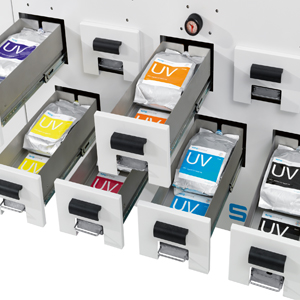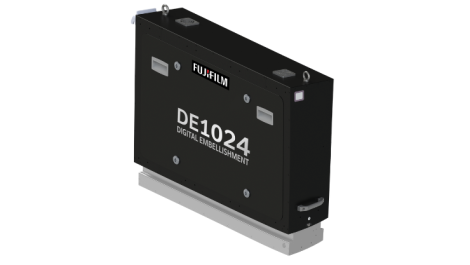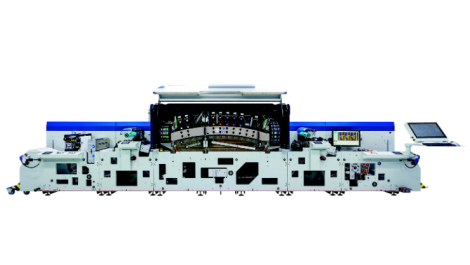The ink station for the Screen Truepress Jet L350UV
Buying a digital press means being tied into an exclusive supply deal for the ink or toner used. There is no choice, the consumable is bespoke to the system. While there may be drawbacks from the lack of competition – although there is much competition in system provider – the benefit of guaranteed performance and quality usually outweighs these. Just look at the high growth rates for digital! By Sean Smyth.
In digital labels and packaging printing, there are water-based and UV curing inkjet inks, and for electrophotography the toner is either solid and liquid. A lot of choice. Inkmakers will tell you that the ink or toner is by far the most important aspect of the digital printing process, because its properties determine how the consumer interacts with the product. A converter may disagree, but they will certainly have an opinion on what is the most important property of an ink or toner. For some it will be printability, others value runnability.
The finished ink film has to be tough and durable, not cracking when folded, not finger marking with good adhesion, non-scratching and be water/oil/solvent resistant on a wide range of substrates. Ink should have a good shelf life and be readily available. It has to be the right colour, with good mileage. It should be environmentally sound (ideally from sustainable raw materials), recyclable and the print must conform to any local legislative requirements in terms of product safety. And not least, it must be cost effective.
The science bit
There is a lot of material science in an ink or toner. They are all comprised of colourants in a vehicle that allows them to be printed and then performs well as the printed film through the life of the pack.
Pigmented inkjet ink is not a specific chemical, it is a colloidal suspension, where microscopically dispersed insoluble particles are suspended throughout another substance. This is a homogenous mixture with a tough binder in solvent to adjust the viscosity; there may be driers and additives to boost durability, slip, stability on press or in an inkjet head.
Powder toner particles are 5 to 8 microns in size, composed of a thermoplastic resin polymer binder with colourant and charge control agent. Most toner is produced using melt pulverisation, where the ingredients are mixed and heated to form a homogenous mixture. This is then cooled and pulverised mechanically, with ultrasound techniques increasingly used, to size and packed. Chemically prepared toners are being developed where the particles are precipitated from solution, providing precise control over the shape and surface roughness of particles with claimed print quality improvements.
Toner technology
Xeikon has improved its QA-I powder toner over the past few years, specifically addressing the needs of labels and packaging. These include food safe formulations, lightfastness, one-hit opaque white, and lowering the fusing temperature to save energy which has the benefit of allowing more substrates (including PE) to be printed. In the Cheetah technology, the toner particles are smaller than in previous versions. Xeikon said this helps with image development at high speed, and lowers toner consumption, so reducing the overall cost of printing.
HP Indigo uses a low viscosity liquid toner, known as Electroink. The vehicle is a resin dispersed in Isopar, a high-purity isoparaffinic solvent that forms a paste into which organic pigment and charge carrier is dispersed using a bead mill. Manufacturing is very similar to litho ink, producing a concentrate in special cans loaded into the press where it is diluted with the Isopar print oil to form a low viscosity fluid. This passes over the plate where the positive particles in the ink are attracted to the negatively charged image. The binary ink developer removes ink from the non-image area and passes it onto the warm blanket. This causes the print oil to evaporate (there is a very efficient recovery system that greatly recycles the oil) and forms the ink film that is transferred onto the paper.

Ink from SPGPrints for the DSI UV inkjet press
Ink for jetting
Inkjet ink, whether UV or water based, is pigment dispersed into a low viscosity vehicle. The pigment tends to be smaller particle size than used in flexo or litho inks, and there is a lower pigment loading. There is an awful lot of technology in getting that pigment stabilised in the ink and delivering the brightest, most saturated colours. Pigment must be small, uniform particles, usually between 50 to 150 nm in diameter. They may be chemically modified at the surface, by adsorption of suitable compounds onto the pigment. These could be low molecular weight derivatives or polymeric dispersants, stabilising the particles by steric repulsion or by charge repulsion. Such chemical treatments and improved physical dispersion technology to wet the pigment, breaking down aggregates and agglomerates and avoiding flocculation, have allowed higher pigment loadings in inks. Mechanical dispersion milling and grinding methods are being enhanced with new techniques such as ultrasonics to improve the physical dispersing and in some cases to minimise the final pigment particle size distribution.
These are dispersed into a low viscosity medium with binder, using a bead mill that continually mills the mixture, sometimes over four or five days per batch that can be up to several thousand litres. The temperature will be carefully maintained and inkmakers will add dispersion aids, speciality chemicals to boost colour strength, modify the surface tension, reduce and control viscosity while delivering stable, uniform particle size and distribution. One manufacturer of these is Lubrizol, which makes Solsperse hyperdispersants. These improve flow characteristics and reduce millbase viscosity while optimising particle and pigment distribution during the milling process. Just as important, dispersants provide flocculation resistance (stopping formation of lumps) and improved ink filtration for production ease.
The use of dispersion aids may affect the performance on the substrate. When printed the wet ink drop has to spread on the surface to a controlled amount, with minimal colour penetration into an absorbent substrate and then dried. Inkjet substrates can be primed, causing the pigment and resin binder to coagulate at the surface instantly, controlling spreading avoiding penetration into the body of an absorbent stock and reducing density.
Primers can be important in promoting adhesion and printability on many substrates for digital printing. HP Indigo provides an inline priming unit as part of the 20000 and 30000 packaging presses. Speciality chemical company Michelman supplies a range of primers for different substrates. There are several inkjet suppliers, including Lubrizol which sells the Printrite range of ink receptive coatings. These promote sharpness, ink dry time, high colour density, with adhesion and scratch resistance on film media.
Colour correct
Most digital inks and toners are the four process colours, cyan, magenta, yellow and black. Colour management to match spot colours accurately is critical. In packaging a good white is very important. HP Indigo presses are usually supplied with seven colour stations, and offer the capability of printing true spot colours or adding additional colours to increase the colour gamut.
The Indigo print mechanism allows white to be printed first, last or sandwiching process colours for double-sided applications, as is also the case with the Epson SurePress L-4033AW. In Xeikon and most inkjet presses, the white position is fixed either as a base or top white (unless there are two white units). The Edale/FFEI Graphium sports a novel rail mechanism that allows the white position to be changed before or after the process colour. There is also a requirement for special colours. HP Indigo released a metallic toner (since withdrawn) and Xeikon has a couple of silver toners; both will supply security toners. Metallic effect inks are under development for inkjet, but there are few in operation.
Improving toner technology is one factor that has enabled Xeikon to broaden its applications beyond labels into flexibles and cartons. Filip Weymans, director segment marketing and business development labels and packaging at Xeikon, stresses the importance of the toner in folding cartons. He said, ‘We are actually the only technology not using any mineral oils, which is a big topic amongst folding carton producers. Competitive systems do use mineral oils, while UV inkjet has issues with photoinitiators. Xeikon on the other hand does not require a functional barrier in common food applications and we think this is a big advantage.’
Much packaging is for food and beverage, where product safety is probably the biggest single issue faced by brand-owners. While there are different regulations across the world effectively an ink, toner or coating must not affect the final product in any way. The attention of most suppliers is firmly on delivering low migration systems, used correctly to minimise any risks.
So, there is a lot behind that can of electroink, bottle of inkjet ink and pack of toner. It just works to print consistent, high quality output on a very wide variety of stocks from unsupported film to corrugated, on cartons and rigid plastics and tins. For every shift. The use of primers further widens the substrate range, as volumes grow the suppliers will pre-treat their products to simplify digital production. This has largely happened in labels and will grow in flexibles, corrugated, cartons and in rigid plastics, glass and metal.






